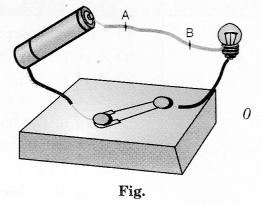CBSE Class 7 Science – MCQ and Online Tests – Unit 14 – Electric Current and Its Effects
Every year CBSE students attend Annual Assessment exams for 6,7,8,9,11th standards. These exams are very competitive to all the students. So our website provides online tests for all the 6,7,8,9,11th standards’ subjects. These tests are also very effective and useful for those who preparing for any competitive exams like Olympiad etc. It can boost their preparation level and confidence level by attempting these chapter wise online tests.
These online tests are based on latest CBSE syllabus. While attempting these, our students can identify their weak lessons and continuously practice those lessons for attaining high marks. It also helps to revise the NCERT textbooks thoroughly
CBSE Class 7 Science – MCQ and Online Tests – Unit 14 – Electric Current and Its Effects
Choose the correct answer:
Question 1.
The amount of heat produced in a wire depends on
(a) material
(b) length
(c) thickness
(d) all of these
Answer
Answer: (d) all of these
Question 2.
When a switch is in OFF position.
(i) circuit starting from the positive terminal of the cell stops at the switch.
(ii) circuit is open.
(iii) no current flows through it.
(iv) current flows after some time.
Choose the combination of correct answer from the following:
(a) all are correct
(b) (ii) and (iii) are correct
(c) only (iv) is correct
(d) only (i) and (ii) are correct
Answer
Answer: (b) (ii) and (iii) are correct
Question 3.
Where can the key or switch be placed in the circuit?
(a) Left side of the battery
(b) Right side of the battery
(c) Can be placed anywhere in the circuit
(d) Near the positive terminal of the bulb
Answer
Answer: (c) Can be placed anywhere in the circuit
Question 4.
Which mark is necessary on electric appliances?
(a) AGMARK
(b) ISI
(c) FICCI
(d) KSK
Answer
Answer: (b) ISI
Question 5.
Which one of the following is based on the heating effect of current?
(a) Geyser
(b) Hair dryer
(c) Immersion rod
(d) All of these
Answer
Answer: (d) All of these
Question 6.
The coil of wire contained in an electric heater is known as
(a) component
(b) element
(c) circuit
(d) spring
Answer
Answer: (b) element
Question 7.
In making a battery
(a) positive terminal of one cell is connected to the negative terminal of the next cell
(b) positive terminal of one cell is connected to the positive terminal of the next cell
(c) negative terminal of one cell is connected to the negative terminal of the next cell
(d) none of the above
Answer
Answer: (a) positive terminal of one cell is connected to the negative terminal of the next cell
Question 8.
Which of the following precautions need not be taken while using electric gadgets / appliances/circuit?
(a) We should never touch a lighted electric bulb connected to the mains.
(b) We should never experiment with the electric supply from the mains or a generator or an inverter.
(c) We should never use just any wire or strip of metal in place of a fuse.
(d) We should never turn the switch in ON position.
Answer
Answer: (d) We should never turn the switch in ON position.
Question 9.
When an electric current flows through a copper wire AB as shown in Figure, the wire
(a) deflects a magnetic needle placed near it
(b) becomes red hot
(c) gives electric shock
(d) behaves like a fuse
Answer
Answer: (a) deflects a magnetic needle placed near it
Question 10.
Choose the statement which is not correct in the case of an electric fuse.
(a) Fuses are inserted in electric circuits of all buildings.
(b) There is a maximum limit on the current which can safely flow through the electric circuits.
(c) There is a minimum limit on the current which can safely flow in the electric circuits.
(d) If a proper fuse is inserted in a circuit it will blow off if current exceeds the safe limit.
Answer
Answer: (c) There is a minimum limit on the current which can safely flow in the electric circuits.














0 Comments:
Post a Comment